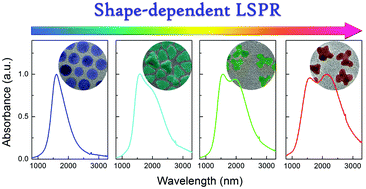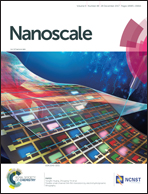Triangle-, tripod-, and tetrapod-branched ITO nanocrystals for anisotropic infrared plasmonics†
Abstract
While many sophisticated geometries of metallic nanoparticles have been explored for plasmon resonance in the visible light waveband, similar structures for infrared plasmonics have seldom been studied. Herein, for the first time, we report branched colloidal Sn-doped In2O3 (ITO) NCs prepared through heating metal organic precursors in a high boiling solvent and surfactants via a simple one-pot method and their interesting anisotropic infrared plasmonics. Shaped ITO NCs were anisotropically grown into triangles, tripods, and tetrapods from spherical particles by tuning the composition of the surfactants. Interestingly, such anisotropic ITO NCs exhibit shape-dependent localized surface plasmon resonances. A new peak emerged at a low energy band, and the peak intensity increases when the particles become more anisotropic. Meanwhile, a redshift of this newly emerging peak and a blueshift of the original peak can also be observed. The proposed overlapping spheroid model successfully explained those features and the calculated extinction spectra matched excellently with the experimental data. Moreover, the origins of those peaks were also revealed and assigned to in-plane longitudinal and out-of-plane transverse modes, respectively. This work may help design more sophisticated structures for infrared plasmonics and broaden its applications in various areas.



 Please wait while we load your content...
Please wait while we load your content...